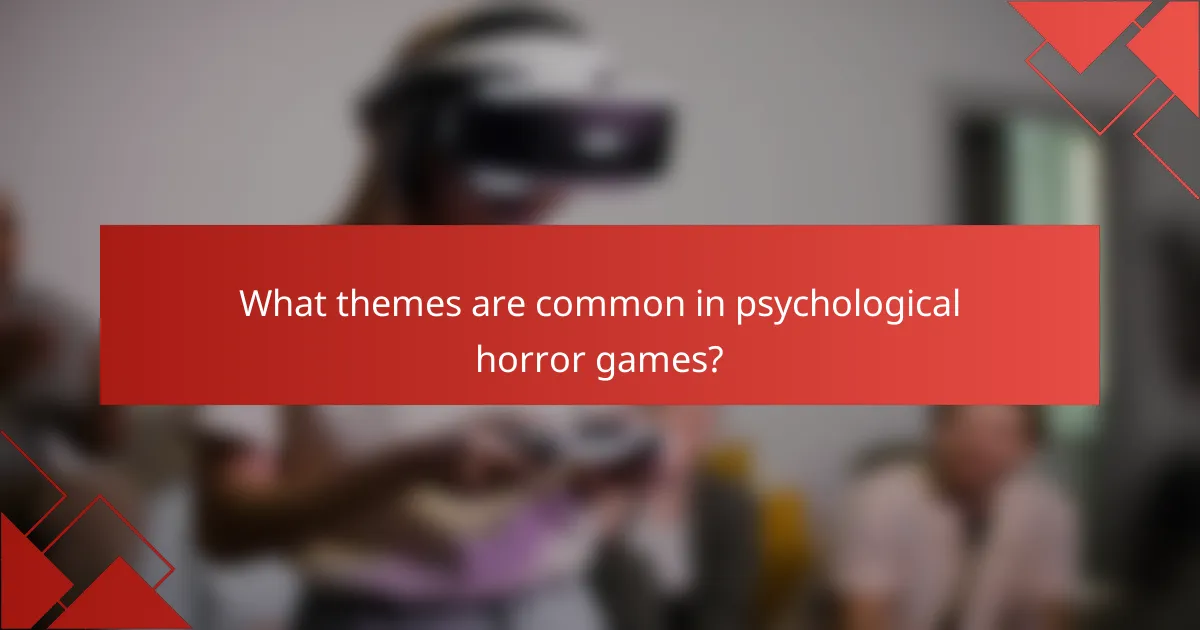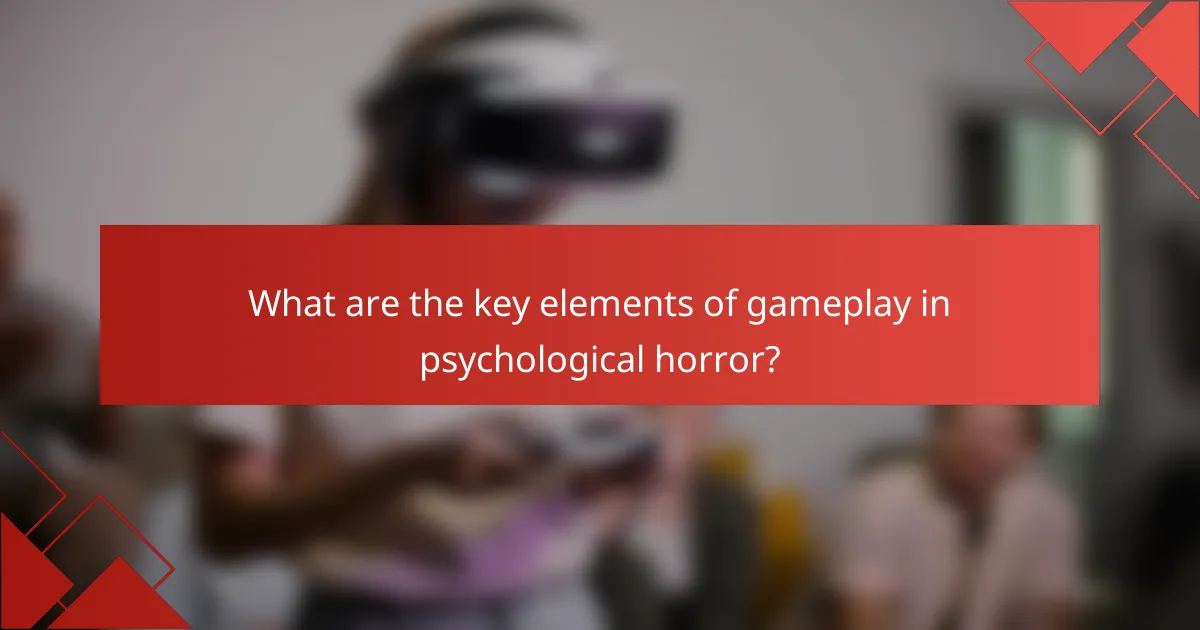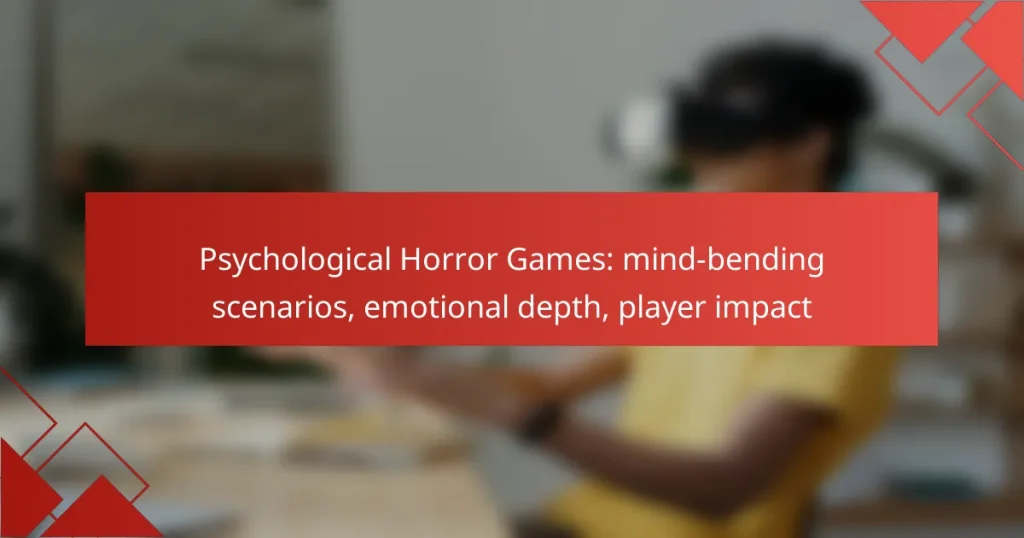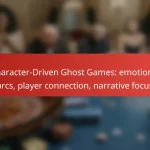Psychological horror games are designed to immerse players in unsettling narratives that challenge their perceptions of reality and evoke profound emotional responses. By exploring themes such as isolation and identity, these games create mind-bending scenarios that leave a lasting impact on players, often blurring the lines between reality and illusion.

What are the best psychological horror games?
The best psychological horror games immerse players in mind-bending scenarios that challenge their perception of reality while evoking deep emotional responses. These games often focus on narrative depth and player impact, creating experiences that linger long after the game is over.
Silent Hill 2
Silent Hill 2 is widely regarded as a cornerstone of psychological horror gaming, known for its haunting atmosphere and complex narrative. Players navigate the fog-shrouded town of Silent Hill, confronting their own fears and guilt through the protagonist, James Sunderland.
The game employs symbolism and surreal imagery to create a deeply unsettling experience. Its use of sound design and ambient music enhances the emotional weight, making players question what is real and what is a manifestation of James’s psyche.
Amnesia: The Dark Descent
Amnesia: The Dark Descent places players in a first-person perspective where they must escape a dark castle while avoiding terrifying creatures. The game emphasizes psychological horror through its sanity mechanic, where darkness and fear can lead to hallucinations and panic.
Players must solve puzzles and manage resources carefully, as light sources are limited. The narrative unfolds through notes and environmental storytelling, creating a sense of dread and urgency that keeps players on edge.
Layers of Fear
Layers of Fear is a first-person psychological horror game that explores the mind of a painter descending into madness. Players navigate a constantly shifting Victorian mansion, where the environment changes based on the protagonist’s mental state.
The game effectively uses visual and auditory cues to create a disorienting experience. Each room reveals pieces of the painter’s troubled past, leading to a deeper understanding of his emotional turmoil and the impact of his art.
Resident Evil 7: Biohazard
Resident Evil 7: Biohazard revitalizes the franchise by incorporating psychological horror elements into its survival horror gameplay. Set in a derelict plantation, players experience a first-person perspective that heightens immersion and tension.
The game combines exploration, resource management, and puzzle-solving with a gripping narrative about a family infected by a mysterious bioweapon. The atmosphere is thick with dread, and players must confront both physical and psychological threats throughout their journey.
Outlast
Outlast is a first-person survival horror game set in an abandoned psychiatric hospital, where players assume the role of an investigative journalist. The game emphasizes stealth and evasion, as players cannot fight back against the terrifying inhabitants of the asylum.
With limited resources and a night-vision camera, players must navigate dark corridors while uncovering the dark secrets of the facility. The game’s intense atmosphere and shocking moments create a profound sense of vulnerability and fear, making it a standout in the psychological horror genre.

How do psychological horror games impact players?
Psychological horror games significantly impact players by immersing them in unsettling narratives that provoke emotional and cognitive responses. These games often challenge players’ perceptions of reality, leading to lasting effects on their mental state and emotional well-being.
Emotional engagement
Emotional engagement in psychological horror games is heightened through deep storytelling and character development. Players often form attachments to characters, experiencing their fears and dilemmas, which can evoke strong feelings of empathy and anxiety.
For instance, a game that explores themes of loss or betrayal can resonate deeply, making players reflect on their own experiences. This emotional connection can lead to a more immersive gaming experience, where players feel genuinely invested in the outcome.
Fear response
The fear response in psychological horror games is crafted through atmosphere, sound design, and unexpected plot twists. These elements work together to create tension and suspense, triggering physiological reactions such as increased heart rate and heightened alertness.
Players may encounter scenarios that induce fear through isolation or the unknown, which can lead to a sense of vulnerability. This fear can be both thrilling and distressing, often lingering long after the game is over.
Cognitive dissonance
Cognitive dissonance arises when players are confronted with conflicting emotions or beliefs during gameplay. For example, a player may feel compelled to make morally ambiguous choices that clash with their personal values, creating internal conflict.
This dissonance can enhance the psychological horror experience, as players grapple with the implications of their decisions. It encourages reflection on their own morality and the nature of fear, making the gameplay experience more profound and thought-provoking.

What themes are common in psychological horror games?
Psychological horror games often explore themes that delve into the human psyche, creating unsettling experiences that challenge players’ perceptions and emotions. Common themes include isolation, identity, and the blurred lines between reality and illusion, each contributing to a deeply immersive and often disturbing narrative.
Isolation and loneliness
Isolation and loneliness are central themes in psychological horror games, often manifesting through environments that evoke a sense of abandonment. Players may find themselves in desolate settings, amplifying feelings of fear and helplessness as they navigate through eerie landscapes without companionship.
These themes can be enhanced by gameplay mechanics that limit communication or resources, forcing players to confront their solitude. For instance, games may restrict access to safe zones or create scenarios where characters are cut off from others, heightening the emotional impact of isolation.
Identity and memory
Identity and memory play crucial roles in psychological horror, often leading players to question their own sense of self. Characters may experience fragmented memories or undergo transformations that challenge their understanding of who they are, creating a disorienting experience.
This theme can be illustrated through narrative twists where players uncover hidden truths about their characters or face consequences of past actions. Games may utilize flashbacks or unreliable narrators to deepen the exploration of identity, prompting players to piece together their character’s history while grappling with the implications of their choices.
Reality versus illusion
The theme of reality versus illusion is prevalent in psychological horror games, where players frequently encounter situations that blur the lines between what is real and what is imagined. This theme creates tension and uncertainty, as players must navigate through deceptive environments and scenarios that challenge their perceptions.
Developers often employ visual and auditory distortions to enhance this theme, making players question their surroundings and the motivations of characters. For example, a seemingly safe area may suddenly transform into a nightmarish landscape, forcing players to confront their fears and reassess their understanding of reality.

What are the key elements of gameplay in psychological horror?
Key elements of gameplay in psychological horror include immersive storytelling, unsettling soundscapes, and deep character development. These components work together to create an experience that challenges players’ perceptions and evokes strong emotional responses.
Atmospheric storytelling
Atmospheric storytelling is crucial in psychological horror, as it builds tension and engages players on a deeper level. This narrative style often incorporates surreal or ambiguous elements that leave players questioning reality and their own sanity.
Effective atmospheric storytelling can be achieved through rich environments, symbolic imagery, and non-linear narratives. Games like “Silent Hill” and “Amnesia: The Dark Descent” exemplify how a haunting backdrop can enhance the overall experience.
Sound design
Sound design plays a pivotal role in psychological horror by creating an unsettling ambiance that heightens fear and anxiety. This includes the use of eerie sound effects, dissonant music, and silence to evoke emotional responses.
Consider incorporating dynamic audio that reacts to player actions, such as footsteps echoing in empty hallways or whispers that seem to come from nowhere. Games like “Resident Evil” and “Layers of Fear” utilize sound effectively to immerse players in their terrifying worlds.
Character development
Character development is essential in psychological horror, as it allows players to form emotional connections with the protagonists. Well-developed characters often face internal struggles, which can mirror the external horrors they encounter.
To enhance character depth, consider incorporating backstories that reveal vulnerabilities and motivations. Games such as “Hellblade: Senua’s Sacrifice” showcase how a character’s mental health journey can intertwine with the horror elements, making the experience more impactful.

How do developers create emotional depth in psychological horror games?
Developers create emotional depth in psychological horror games by crafting immersive narratives and complex characters that resonate with players. They often employ techniques such as environmental storytelling, player choice, and psychological themes to evoke strong feelings and provoke thought.
Character Development
Character development is crucial for emotional engagement in psychological horror games. Developers often create multi-dimensional characters with relatable fears, desires, and flaws. This depth allows players to form emotional connections, making the horror elements more impactful.
For example, a character struggling with guilt over past actions can evoke empathy and heighten tension as players navigate their journey. By presenting characters with realistic emotional arcs, developers can enhance the overall experience.
Narrative Techniques
Narrative techniques play a significant role in establishing emotional depth. Developers often use unreliable narrators, fragmented storytelling, and non-linear plots to immerse players in a disorienting experience. These methods can create a sense of unease and compel players to question their perceptions.
Incorporating themes of loss, trauma, or existential dread can further deepen the emotional resonance. Games like “Silent Hill” and “Amnesia” effectively utilize these techniques to draw players into their haunting narratives.
Environmental Storytelling
Environmental storytelling enhances emotional depth by using game settings to convey themes and emotions. Developers design environments that reflect the psychological state of characters or the overarching narrative. Subtle details, such as abandoned objects or eerie soundscapes, can evoke feelings of dread and isolation.
For instance, a dilapidated house filled with remnants of a family can tell a story of loss and despair without explicit dialogue. This approach allows players to engage with the narrative on a deeper level, fostering a more immersive experience.
Player Choice and Consequences
Player choice and consequences are vital for creating emotional depth in psychological horror games. Allowing players to make decisions that affect the story can lead to a more personalized experience. These choices often come with moral dilemmas, forcing players to confront their values and emotions.
Games like “The Walking Dead” series exemplify this approach, where player decisions can lead to significant emotional outcomes. The weight of these choices can enhance the player’s investment in the narrative and its characters.


